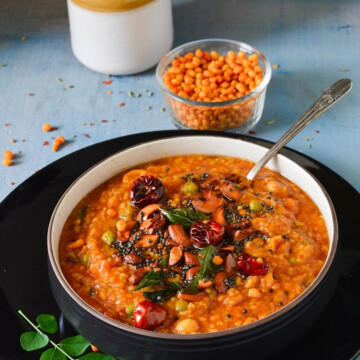
Bisi Bele Bath Recipe
Bisi Bele Bath is a traditional Karnataka dish made from rice, lentils, and mixed vegetables, cooked together with a flavorful spice mix. The name translates to "hot lentil rice," and it's often seasoned with tamarind and served with ghee, yogurt, or pickles. It's a nutritious, one-pot meal that embodies rich flavors and is commonly enjoyed for lunch or dinner.
Ingredients
Ingredients:
- 1 Cup Moong dal (split yellow lentils)
- 1 Cup Rice
- ½ Cup Mixed vegetables (carrots, beans, potatoes, peas)
- 1 Large onion, chopped
- 2 Tomatoes, chopped
- 1 Green chili, slit
- 1 tablespoon Tamarind paste
- 2 tablespoon Bisi Bele Bath Powder
- 1 teaspoon Mustard seeds
- 1 teaspoon Cumin seeds
- 1 tablespoon Oil or ghee
- A few curry leaves
- 1 Pinch hing (asafoetida)
- Salt to taste
- Fresh cilantro for garnish
Instructions
Prepare Ingredients
- To start, rinse the moong dal and rice separately under cold water. Next, chop the vegetables into bite-sized pieces and set them aside. Also, even if you use different types of vegetables, make sure they are cut evenly so they cook at the same time.
Cook the Lentil and Rice
- In a large pot or pressure cooker, add the rinsed moong dal and rice along with 4 cups of water. Next, you can sprinkle in a pinch of salt. Then, cook everything until it’s soft and mushy.
- To get the right consistency, pressure cook for 2 whistles, or simmer in a pot for about 20 minutes while stirring occasionally. After that, set the cooked dal and rice aside.
Prepare the Vegetables
- First, heat oil or ghee in a large pan. Then, add mustard seeds and cumin seeds. As soon as they start to crackle, add the chopped onions and green chili. Next, sauté everything until the onions turn golden brown.
- After that, add the chopped tomatoes and cook them until they become soft and the oil starts to separate. Next, add the mixed vegetables and cook for about 5-7 minutes.
Add Spices and Tamarind
- Finally, add the Bisi Bele Bath Powder and tamarind paste to the vegetable mixture. Then, stir well to mix the spices evenly. If the mixture seems thick, add about 1-2 cups of water to get the right consistency.
- Simmer for another 10 minutes, or until the vegetables are tender. During this time, keep an eye on them to make sure they cook just right.
Combine Dal, Rice and Vegetables
- Now that the vegetables are cooked, add the cooked dal and rice mixture to the pan. Then, mix everything together well. Finally, let it simmer for about 5 minutes to blend the flavors.
Final Touches
- Next, check the seasoning and add more salt if needed. Then, sprinkle in a pinch of hing and fresh cilantro for garnish. This last step makes the dish smell great and look nice!
Notes
Variations of Bisi Bele Bath
Vegan Bisi Bele Bath: To make this dish vegan, simply swap out ghee with coconut oil or vegetable oil and ensure there’s no dairy. Vegetable Variations: You can add a wide range of vegetables to Bisi Bele Bath—carrots, peas, beans, potatoes, and even drumsticks (moringa). Some people like to keep it simple. Others go for a colorful veggie mix! Protein Additions: For a protein boost, you can add tofu, paneer, or even chicken pieces to the dish. These protein-packed additions make the dish even more filling!Bisi Bele Bath for Beginners: Easy Tips and Tricks
Best Cooking Tools: Using a pressure cooker or slow cooker makes it easier to cook rice and dal to the perfect texture. These tools also save you time and effort! How to Avoid Common Mistakes: One common mistake is overcooking the rice and dal, which can make the dish mushy. Keep an eye on your cooking time, and don’t skip the simmering step! Quick Fixes: If your Bisi Bele Bath turns out too spicy, add some extra rice or a bit of yogurt to balance the heat.Nutrition
Nutrition Facts
Bisi Bele Bath Recipe
Amount per Serving
Calories
290
% Daily Value*
Fat
8
g
12
%
Saturated Fat
1
g
6
%
Polyunsaturated Fat
1
g
Monounsaturated Fat
4
g
Sodium
400
mg
17
%
Potassium
600
mg
17
%
Carbohydrates
50
g
17
%
Fiber
8
g
33
%
Sugar
3
g
3
%
Protein
10
g
20
%
Vitamin A
600
IU
12
%
Vitamin B2
0.1
mg
6
%
Vitamin B3
2
mg
10
%
Vitamin B5
0.5
mg
5
%
Vitamin B6
0.3
mg
15
%
Vitamin C
20
mg
24
%
Vitamin E
1
mg
7
%
Vitamin K
4
µg
4
%
Calcium
30
mg
3
%
Iron
2
mg
11
%
* Percent Daily Values are based on a 2000 calorie diet.
Tried this recipe?Let us know how it was!